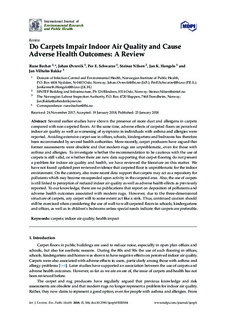| dc.contributor.author | Becher, Rune | |
| dc.contributor.author | Øvrevik, Johan | |
| dc.contributor.author | Schwarze, Per Everhard | |
| dc.contributor.author | Nilsen, Steinar Klubben | |
| dc.contributor.author | Hongslo, Jan Kenneth | |
| dc.contributor.author | Bakke, Jan Vilhelm | |
| dc.date.accessioned | 2018-06-19T11:20:43Z | |
| dc.date.available | 2018-06-19T11:20:43Z | |
| dc.date.created | 2018-02-07T13:26:55Z | |
| dc.date.issued | 2018 | |
| dc.identifier.issn | 1660-4601 | |
| dc.identifier.uri | http://hdl.handle.net/11250/2502096 | |
| dc.description.abstract | Several earlier studies have shown the presence of more dust and allergens in carpets compared with non-carpeted floors. At the same time, adverse effects of carpeted floors on perceived indoor air quality as well as worsening of symptoms in individuals with asthma and allergies were reported. Avoiding extensive carpet use in offices, schools, kindergartens and bedrooms has therefore been recommended by several health authorities. More recently, carpet producers have argued that former assessments were obsolete and that modern rugs are unproblematic, even for those with asthma and allergies. To investigate whether the recommendation to be cautious with the use of carpets is still valid, or whether there are new data supporting that carpet flooring do not present a problem for indoor air quality and health, we have reviewed the literature on this matter. We have not found updated peer reviewed evidence that carpeted floor is unproblematic for the indoor environment. On the contrary, also more recent data support that carpets may act as a repository for pollutants which may become resuspended upon activity in the carpeted area. Also, the use of carpets is still linked to perception of reduced indoor air quality as well as adverse health effects as previously reported. To our knowledge, there are no publications that report on deposition of pollutants and adverse health outcomes associated with modern rugs. However, due to the three-dimensional structure of carpets, any carpet will to some extent act like a sink. Thus, continued caution should still be exercised when considering the use of wall-to-wall carpeted floors in schools, kindergartens and offices, as well as in children’s bedrooms unless special needs indicate that carpets are preferable | nb_NO |
| dc.description.sponsorship | Acknowledgments: This study has not received any funding or grants. NIPH cover the costs for publishing in open access. | nb_NO |
| dc.language.iso | eng | nb_NO |
| dc.publisher | MDPI | nb_NO |
| dc.rights | Navngivelse 4.0 Internasjonal | * |
| dc.rights.uri | http://creativecommons.org/licenses/by/4.0/deed.no | * |
| dc.subject | Carpets | nb_NO |
| dc.subject | Indoor air quality | nb_NO |
| dc.subject | Health impact | nb_NO |
| dc.title | Do Carpets Impair Indoor Air Quality and Cause Adverse Health Outcomes: A Review | nb_NO |
| dc.type | Journal article | nb_NO |
| dc.type | Peer reviewed | nb_NO |
| dc.description.version | publishedVersion | nb_NO |
| dc.rights.holder | This is an open access article distributed under the Creative Commons Attribution License which permits unrestricted use, distribution, and reproduction in any medium, provided the original work is properly cited. (CC BY 4.0) | nb_NO |
| dc.subject.nsi | VDP::Teknologi: 500 | nb_NO |
| dc.source.volume | 15 | nb_NO |
| dc.source.journal | International Journal of Environmental Research and Public Health | nb_NO |
| dc.source.issue | 2184 | nb_NO |
| dc.identifier.doi | 10.3390/ijerph15020184 | |
| dc.identifier.cristin | 1562823 | |
| cristin.unitcode | 7401,30,60,0 | |
| cristin.unitname | SINTEF Certification | |
| cristin.ispublished | true | |
| cristin.fulltext | original | |
| cristin.qualitycode | 1 | |

